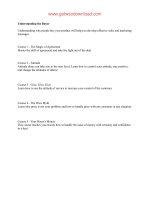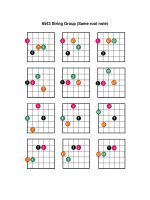Amacom effective e mail marketing the complete guide to creating successful campaigns 0 8144 71 tủ tài liệu bách khoa
Bạn đang xem bản rút gọn của tài liệu. Xem và tải ngay bản đầy đủ của tài liệu tại đây (2.7 MB, 284 trang )
TE
AM
FL
Y
Effective E-Mail
Marketing
Effective E-Mail
Marketing
The Complete Guide to Creating
Successful Campaigns
HERSCHELL GORDON LEWIS
American Management Association
New York • Atlanta • Brussels • Buenos Aires • Chicago • London • Mexico City
San Francisco • Shanghai • Tokyo • Toronto • Washington, D. C.
Special discounts on bulk quantities of AMACOM books are available to corporations, professional associations, and other organizations. For details, contact Special Sales Department,
AMACOM, a division of American Management Association,
1601 Broadway, New York, NY 10019.
Tel.: 212-903-8316. Fax: 212-903-8083.
Web site: www.amacombooks.org
This publication is designed to provide accurate and authoritative information in regard to the
subject matter covered. It is sold with the understanding that the publisher is not engaged in
rendering legal, accounting, or other professional service. If legal advice or other expert assistance is required, the services of a competent professional person should be sought.
Library of Congress Cataloging-in-Publication Data
Effective e-mail marketing: the complete guide to creating successful campaigns /
Herschell Gordon Lewis
p. cm.
Includes index.
ISBN 0-8144-7147-1
1. Internet marketing. 2. Electronic mail systems. I. Title: E-mail marketing. II. Title:
E-mail marketing. III. Title.
HF5415.1265 .L482 2002
658.8’4—dc21
2002001933
© 2002 Herschell Gordon Lewis.
All rights reserved.
Printed in the United States of America.
This publication may not be reproduced,
stored in a retrieval system,
or transmitted in whole or in part,
in any form or by any means, electronic,
mechanical, photocopying, recording, or otherwise,
without the prior written permission of AMACOM,
a division of American Management Association,
1601 Broadway, New York, NY 10019.
Printing number
10 9 8 7 6 5 4 3 2 1
Contents
Preface
vii
Acknowledgments
xi
Chapter 1: Effective E-Mail—
The Communications Revolution
1
Chapter 2: Adapting Your Message to This Medium
9
Chapter 3: How to Get Opt-Ins
33
Chapter 4: Avoiding the “Spam” Accusation
53
Chapter 5: That Magical Ingredient—Rapport
85
Chapter 6: Psychology Over Technology:
A Valid Conclusion?
105
Chapter 7: The All-Important Subject Line
129
Chapter 8: Personalization and Relevance
141
Chapter 9: Holding On to Fragile Response
153
Chapter 10: Words and Phrases That Work
167
Chapter 11: Words and Phrases That Don’t Work
179
v
Contents
vi
Chapter 12: Structuring Sentences and
Paragraphs That Persuade
185
Chapter 13: How to Reduce Opt-Outs
193
Chapter 14: The Interval Enigma:
How Often Should You E-Mail?
207
Chapter 15: Monday and Friday—Poor E-Mail Days?
213
Chapter 16: Rich Media and Viral Mail
217
Chapter 17: Sample E-Mails: The Good,
the Bad, and the Ugly
241
Chapter 18: “And in conclusion, ladies and gentlemen . . .” 257
Appendix: A Potpurri of Tips
263
Index
273
About the Author
287
Preface
E-mail is the first force-communication phenomenon of the twentyfirst century.
In a single package, we have total “one-to-one”—that is, total
command of the recipient’s attention. We also have complete capability of message testing and an unprecedented ease of transmission. (In fact, e-mail is an easier form of communication than
speech, because the e-mail sender can catch and repair errors that
readily slip out between the lips.)
But e-mail has a problem.
It is the problem that besets any apparently simple success story:
Everybody—everybody—is an expert. And do you know what happens when everybody is an expert? Mistakes compound themselves
because we so-called experts don’t recognize mistakes as mistakes.
What types of mistakes that will reduce response and revenue
might the commercial e-mail sender commit? Even a preliminary
list is formidable:
• Overmailing (see Chapter 4)
• Undermailing (see Chapter 14)
• Using dull descriptions (see Chapter 11)
• Sending the identical message repeatedly (see Chapter 13)
vii
Preface
viii
• Not knowing the demographic of your targets (see Chapter 6)
• Not making rapport the key of every message (see Chapter 5)
• Assuming all your targets share the same demographic/psy-
chographic profile (see Chapter 1)
• Eliminating target groups merely because you don’t think they
might respond (see Chapter 6)
• Refusing to test (see Chapter 1)
• Assuming that what works for direct mail automatically works
for e-mail (see Chapter 2)
And that is just a starter list. But yes, mistakes are there to be
made. And mistakes in e-mail invariably reduce response and revenue.
Are you reading this in the year 2004? Three years earlier Jupiter
Research predicted that by this year, e-mail would command 15 percent of all advertising dollars. Were they overenthusiastic or too conservative?
Are you reading this in the year 2005? Then you can determine
whether a prediction made four years earlier by IDC of Framingham,
Massachusetts, is valid: that by 2005 there will be 35 billion commercial e-mail messages per day. That’s nothing: The same source
says total e-mails—personal as well as business—will be 9.2 trillion.
And remember, personal e-mails fight for attention against commercial e-mails. Talk about competition! You had better be an expert.
Are you reading this in the year 2006? Then you may dismiss as
an anecdote a “study” by Forrester Research that predicted by 2006,
40 percent of people who have at least four years of Internet-surfing
experience would generally ignore e-mail marketing. Do you agree
with that? I don’t. This so-called study not only deals in opinions
rather than results but also parallels someone saying he or she is
bored with television, doesn’t read a newspaper, or has no interest
in sex.
Preface
If you don’t care about reduced response and revenue, this book
isn’t for you. If you care about reduced response and revenue, I
promise you’ll find a nugget here and there that will more than justify the leap of faith you took when picking up this book in the first
place.
And oh, before I forget: If you’re looking for a book loaded with
technical terms, impenetrable acronyms, and arcane terminology,
this isn’t it. This is a book about e-mail marketing—which makes it
possible for those term-throwers to exist at all.
—Herschell Gordon Lewis
Fort Lauderdale, Florida
ix
Acknowledgments
I am deeply indebted to Jock Bickert of The Looking Glass. This
astute marketer, who developed the “Cohorts” segmentation that
has repeatedly produced quantum leaps in response, not only made
invaluable suggestions but also allowed me to test multiple e-mail
concepts and then shared the results and analyses with me.
For the same reason, I offer my gratitude to Carol Bond of Carol
Bond Health Foods, and Joel Irwin and Mark Irace of Proflowers.com.
These intelligent marketers have shown a willingness to test e-mail
copy and techniques, and I have profited mightily from being
involved in the creation of their e-mailings.
Robert Dunhill of Dunhill International Lists and Jay Schwedelson of Worldata, both knowledgeable experts, graciously shared
some of their own e-mail experiences with me.
Steve Hardigree, the marketing expert who heads Opt In Inc., is
responsible for opening my eyes to many of the innovations for
which he can claim origination.
My aquisitions editor at AMACOM Books, Ellen Kadin, is the
principal reason this book appears at all. She has shown the kind of
wisdom and patience an author—especially an author of a trade
book—seldom has the pleasure of experiencing. I also salute her
endurance.
To those venues that have allowed me to speak and conduct
e-mail workshops—especially Direct Marketing Days, New York
xi
C
H
A
P
T
E
R
1
AM
FL
Y
Effective E-Mail—
The Communications
Revolution
TE
Let’s start with a quick question: “How many different media do you
need to personalize, adapt to individual groups, test price, determine whether straight text generates more response than a produced message, test message length, be able to read results within
one or two days, test incentives, differentiate messages to business
from messages to consumers, and provide hundreds of demographic splits?”
You know the answer: “One.”
E-mail, to astute marketers, ranks right up there with the Gutenberg Bible and television as a quantum leap forward in the art—or,
more in sync with the twenty-first century, the science—of communication. Make that force-communication, because we, in this environment, aren’t concerned with noncommercial messages. (But we
certainly are concerned with commercial messages we don’t want to
look unprofessional.)
1
Effective E-Mail Marketing
2
E-mail represents the culmination of a communications revolution that began with the telephone—supplementing, augmenting,
and eventually replacing natural one-to-one relationships with bulk,
manufactured, artificial one-to-one pseudorelationships. Refinements, following those of telephone marketing, focus on preventing
the potential customer, client, or donor from recognizing the prefix
“pseudo-.”
E-Mail Offers Advantages to Marketers
Even during the early experimental period, successful and astute
e-mail marketers realized that no previous medium offered the
advantages e-mail brings to the marketing arena. While other dotcom start-ups flared with egotistical self-promotion before flaming
out, e-marketers charted a steady course, spending so little on each
contact that failure was harder to achieve than success.
But I said, successful and astute e-mailers. Those qualifiers thin
the ranks considerably, because successful and astute e-mailers
quickly see the value of testing. They tabulate test results exactly the
way expensive (but in this case unnecessary) researchers would tabulate them. Then, unlike career researchers, they quickly implement
the results of their research, constantly alert to changing market
conditions that might dictate a change in course.
All this may strike you as primitive. I hope it does because that
means you accept testing and skeptical acceptance of test results as
an absolute necessity for successful e-marketing.
Testing Is Crucial
Let’s accept that a generic characteristic of the World Wide Web—not
only e-mail but the Web as a marketing medium—can be explained
in one sentence: The Web is price-driven.
Oh, certainly exceptions exist. But those exceptions are based
on the most elusive of all Web relationships: loyalty. To crack the
Effective E-Mail—The Communications Revolution
marketplace—as one chooses among the motivators that might get
a positive mouse-click—the combination of exclusivity (a natural
element in what appears to be a personalized communication) and
discounted price (a necessary element in the most competitive
marketplace ever developed) has yet to be beaten, and may never
be.
Price testing is the most common test. A suggestion, when you
are testing price, don’t test $24.95 against $29.95. Cross over to the
next ten. So, it would be $29.95 against $39.95. For larger numbers,
bring the discount below the intervening hundred. As in, “Regularly $249. Yours this week only for $189.” Which brings us
to the second testing element: expiration date.
Note the use of the phrase “this week only” because I may point it out several
times in this book. An expiration date always helps response. And the more specific the expiration date, the better the response. So, “Reply by midnight, Friday,
May 25” has greater power than “Reply by Friday, May 25,” which in turn has
greater power than “Reply by May 25.”
Although the Web is price-driven, don’t limit your incentive programs to whatever you may have in your warehouse. Test incentives
against one another. Sweepstakes and newsletters are used nearly as
often as straight discounts. (We’ll discuss newsletters frequently in
this text because the term newsletter is often a mask or wrapping
for commercial messages.) Merchandise ranging from pens
and letter openers to baseballs and mouse pads are popu-
When recruiting customers, clients, or donors, keep the message short. Message
length can increase in ratio to the number of times the prospect has contacted
you.
3
Effective E-Mail Marketing
4
lar incentives. Free shipping is often the runaway winner in an
incentives test. And that is what you should do: Test.
A fourth element worthy of testing is message length. Chapter 2
describes some of the basic rules for e-mail messages. In this chapter, we’re concerned about the benefits of short messages versus
long messages.
And of course technology has to play a part. Should you take the
cheap and easy course by using straight text? Or should you use the
more expensive, time-consuming, and lavish HTML or the visual
and auditory splendor of rich mail? The answer is obvious: Test.
Just be sure, when you test, that the test groups are parallel when
you test. Don’t test one message to your list of prior buyers against a
message to a group of semi-interested names who don’t know you
but unwittingly subscribed to a newsletter on which your message
coattail-rides.
CPM Is Replaced by CPA
For generations, marketers have paid homage to three initials: CPM.
As almost everyone associated with advertising knows, the initials
stand for “cost per thousand.” (M is the Roman numeral for 1,000.)
Publications traditionally based their rate cards on CPM. Broadcast stations, while not always using the initials, employed the same
procedure, by using rating points that equate to the number of
viewers or listeners.
In my opinion, CPM is not only obsolete today, it was obsolete
from the beginning. Smart marketers don’t want to reach the largest
number of people. They want to reach the largest number of people
who can and might respond.
This led to the evolution of a new set of initials: CPA. Originally,
CPA was an acronym for “cost per acquisition,” but recently it has
changed to the more dynamic and flexible “cost per action.” The
benefit to marketers is obvious: They pay only for response, not for
raw exposure.
Effective E-Mail—The Communications Revolution
Steve Hardigree, CEO of Opt In Inc., has been a CPA pioneer. He
writes:
E-mail marketing as an advertising medium will become one
of the dominant resources for the “click and mortar” companies of the new millennium. And due to its relatively low cost,
personalization, and tracking capabilities, it will be the choice
of direct marketers across all vertical markets.
The cost of e-mail marketing will shift from a CPM model to a
CPA or CPA/CPM hybrid, forcing e-mail marketing firms to
become participants in the creation and design of e-mail campaigns in order to benefit in a true “pay for performance” relationship. As a result, e-mail marketing firms will have to put
more sophisticated technology in place to ensure that traffic
generated via their promotions is accounted for (i.e. pixel tracking, 800 number, open rates, click rates, and similar criteria).
Is the CPA model the e-mail giant of the future? Many marketers
hope so because when the medium becomes a salesperson, the
monetary compensation is then structured in the way most major
retailers structure their compensation—as a commission-based
arrangement.
The Medium Is New, The Intention Isn’t
Have you used e-mail for any of these:
• The announcement of special offers, available only by the e-mail
connection?
• Referrals to previous purchases or activities?
• Regular hotline clearance sales?
• Frequent-buyer programs?
5
Effective E-Mail Marketing
6
• Easy-to-win contests with discount coupons as prizes?
• Unexpected rewards?
If you haven’t, you may have missed an extra opportunity to
solidify a relationship that otherwise might be so fragile it can break.
Marketers who separate e-mail from the rest of the marketing
mix are either unaware of a truism or are ignoring it: The customers
and contacts haven’t changed. They are the same people you would
want to reach if e-mail didn’t exist. Whether by e-mail, direct mail,
television, or on the inside of matchbook covers, success comes
from reaching and influencing—at the lowest possible cost—the
largest number of people who can and will respond to your offer.
What e-mail has given the world of force-communication is a
quantum leap in timing, an astounding reduction in cost, and an
automatic one-to-one relationship. Oh, yes, these are gigantic
improvements, but they don’t change the intention.
Which means what?
It means that in e-mail, as in television and printing, technology should be subordinate to principles of psychology. The
most expensive method may not be the most effective.
In e-mails to business, a rich media or “produced” message may be less effective
than straight text. Why? Because straight text is less likely to present the immediate advertising impression, “I want to sell you something.”
A Gartner Inc. study indicated that at least 34 percent of business
e-mails do not contain content employees need to perform their
jobs. The number becomes significant when integrated with another
statistic: 25 percent of the employees surveyed for this study spend
more than an hour each business day going through, or “managing,”
e-mails. The average time spent on e-mails was forty-nine minutes.
Effective E-Mail—The Communications Revolution
A Few Case Histories
Rockport Company LLC, a division of Reebok, decided to build an
e-mail list of opt-ins.
The company sent a sweepstakes offer—a safari in Kenya—to
200,000 names, some of which were already registered, but many of
which were bought from a list company. Rockport reported a 6 percent click-through—12,000—which eventually boiled down to
between 3,000 and 4,000 registrants.
Subsequently, Rockport sent e-mails to 250,000 names, again for
a sweepstakes—this time for a vacation at an Arizona spa. Included
were 20,000 so-called “house names”—names from existing Rockport lists. The company anticipated 8,000 to 10,000 registrants,
announcing it would continue to mix bought names and house
names for ongoing e-mails.
Borders initiated a series of promotional e-mails called Borders
Store Exclusives, sent either monthly or bimonthly to brickand-mortar customers whose e-mail addresses are on file. (The
collection of the names, said to be in excess of one million, was
done at the stores, where customers were asked to sign up
for newsletters and exclusives.) The typical promotion is a 20 percent discount coupon valid at any of the more than three hundred
Borders stores.
The chain reported a double-digit response, plus a click-through
rate of almost 30 percent on a forward-to-a-friend button, which
enables customers to send the same coupon to another person.
These results show an unusually successful venture into the online
referral technique of viral mail (see Chapter 16).
Borders also says it segments its mailings by targeted newsletters, such as Borders Business Class and Borders Lit, based on its customer database.
Freelotto.com has held a series of lotteries that promise major
prizes, including the possibility of up to $11 million each day. When
visitors register, they are asked to provide information that goes well
beyond their online names.
7
Effective E-Mail Marketing
8
E-mailed advertising to registrants underwrites the monetary
prizes, and Freelotto has been able to offer advertisers the possibility
of sophisticated targeting based on demographics stemming
from the registration information.
If you have a sweepstakes or prize offer, plug it on your home page. Don’t
assume that e-mail announcements alone will seize the attention of every name
on the list. Get interaction any way you can, because interaction is the key to
gaining the customer’s often fragile attention to your next e-mail.
The Radical Mail Lesson
A company that flared like a rocket . . . and quickly flared out like a
spent rocket . . . was Radical Mail, whose streaming video and audio
were state of the art. Once regarded as the king of rich media, Radical Mail went out of business in mid-2001.
What happened? Chapter 16 explores the circumstances. I’ll
mention at this point, however, that the outcome of the story serves
as a warning to all e-communicators: E-mail has to motivate. If it
entertains, that’s frosting on the cake. But it has to motivate, regardless of whether or not it’s entertaining. Now, how about the reverse?
Does it have to entertain, whether it motivates or not? The Radical
Mail story, as told later in this book, will answer that question.
C
H
A
P
T
E
R
2
Adapting Your Message
to This Medium
Remember Where You Are
Part of e-mail’s power is inherent in the medium itself. People turn
on their computers and deliberately check who has contacted them
since the last time they logged on . . . which could have been only
half an hour before.
Newspaper and magazine subscribers usually don’t buy these
publications because they want to see advertising. Television viewers dislike commercials so intently that gadgets designed for cutting
out the commercials enjoy a brisk sale. Direct mail, the incestuous
first cousin of e-mail, comes unannounced as does commercial
e-mail, but it lacks the cachet of the glamorous new medium.
Just by being there with their fingers on a mouse, your e-mail targets signal that they expect you. Do they welcome you? The subject
line and first sentence answer that question quickly.
You can see the creative significance of the differential. If you just
retype your direct mail letter, you’ve ignored where you are. Direct
9
10
Effective E-Mail Marketing
mail may be delivered Monday or a week from Thursday. Except for
overnight courier, the printed message can’t begin to match the
immediacy of the e-mail message. (Nor can it begin to match its low
cost.) The statement, “You have only three days left,” makes sense in
e-mail, but not in snail mail.
Although the statement, “You have only three days left,” also
retains timeliness in newspapers and broadcast media, there are
two deficiencies. First, the means of immediate response
isn’t at hand; and second, the one-to-one aspect isn’t there.
The bulk of consumer response to advertising usually arrives within forty-eight
hours. That’s faster than business response, because business recipients typically
aren’t as likely to dedicate time for immediate response, especially on Mondays
and Fridays. (See Chapter 15.)
Impatience Demands Specifics
Nothing is leisurely about the Web. The mouse is merciless, and
boredom is always a threat.
An ancient principle of force-communication is: Get to the point.
This principle must prevail if you want your message to be read . . .
and to generate a response.
Accepting that principle means accepting the corollary that
dominates much of this book’s philosophy: Specifics outpull generalizations.
Figure 2-1 is an offer for golf balls. It’s perfectly adjusted to the
mentality of Web visitors because it’s absolutely specific, with no
embellishments and no wasted adjectives. This straightforward message is in tune with the short attention span, impatience, and
demand for specificity that typifies someone looking at the day’s
e-mail. Would illustrations and slicker production increase the effectiveness of this e-mail? In my opinion, illustrations and production
would damage it by softening the “right now” aspect.
Adapting Your Message to This Medium
11
Figure 2-1. Do you need any golf balls?
Subj:
Date:
From:
Reply-to:
To:
Do You Need Any Golf Balls ??
5:48:37 PM Pacific Standard Time
We Are Currently Offering Great Prices On All Our Titleist Products
Call Us For Additional Information.
Item #
RHS11T
RHS17T
RHS13T
RHS12T
RD31T
RM32T
RD32T
RM20T
SP06TP
SP07TM
AM
FL
Y
$22.95 doz
$23.95 doz
$19.95 doz
$14.95 doz
$15.95 doz
$16.95 doz
$12.95 doz
$11.95 doz
$69.95 10-doz
$39.95 10-doz
TE
Titleist Professional
Titleist Prestige
Titleist Tour Distance
Titleist HP Tours
Titleist HP Distance
Tilteist HP Eclipse
Titleist HVC
Titleist DT
Titleist Professional Blems
Titleist Mixed Blems
These are our superb premium quality golf balls, the finest quality we have available. These are NOT X-OUTS. Call us for more details.
Other great values include:
Strata
MaxFli Revolution
Nike
Taylor Made InnerGels
Precept MC
Precept EV Spin or Distance
Staff Titanium Distance or Spin
$16.95 doz
$19.95 doz
$19.95 doz
$23.95 doz
$14.95 doz
$14.95 doz
$13.95 doz
RHS16T
RHS15
RMS21N
RD46TA
RHS20P
RMS24
RD38W
(continues)
Effective E-Mail Marketing
12
Figure 2-1. (continued)
Pinnacle Xtreme
Top Flite Magna
Slazenger Raw or Spin
Top Flite XL 2000-all models
Ultras
MaxFli MD
Pinnacle Gold
Top Flite XL
Prostaff
$ 9.95 doz
$ 9.95 doz
$16.95 doz
$ 9.95 doz
$ 9.95 doz
$ 8.95 doz
$ 6.95 doz
$ 6.95 doz
$59.95 10-doz
RD40P
RD34TF
RD36S
RD35TF
RD37U
RMS26M
RD41PN
RD35TF
SP08PS
Call us if you don’t see your favorite ball.
We have nearly every kind of ball imaginable, usually at less than half of manufacturer’s suggested list. We also carry a fabulous selection of women’s golf balls,
senior’s balls and optical yellow balls.
3 doz min order
Add $1.50 per doz shipping and handling.
No sales tax unless you live in Texas (Tex residents add 8.25%).
Most orders UPS delivered within 5 days.
All Credit Cards Accepted
Call 888-205-4059 to order by credit card, 281-561-5033 for check-fax orders.
Or call 281-560-0132 from outside the US.
Call us for a complete catalog or for additional information.
Call 8am to 10pm Central Time -Including Weekends- for information or to place
an order.
Best Wishes For Great Golf
Dana Jones
Remember - The Ballman Saves You Money
888-205-4059
281-560-0132
Adapting Your Message to This Medium
13
Asking for Information? Be Careful
Figure 2-2 exemplifies a problem many e-mails self-generate.
These e-mails shroud specificity combining a muzzy offer with a
request for a considerable amount of personal information. An
example would help this generalized offer. Anyone in a heavy-debt
position has seen many such propositions. The ones that bring
response are those that include examples with which the individual can identify.
Figure 2-2. Consolidate your debt.
Subj:
Date:
From:
Reply-to:
To:
CONSOLIDATE YOUR DEBT (ITS My Final Answer ) [9ma4o]
6:10:07 PM Pacific Daylight Time
How would you like to take all of your debt, reduce
or eliminate the interest, pay less per month, and
pay them off sooner?
We have helped over 20,000 people do just that.
If you are interested, we invite you request our free
information by provide the following information.
Full Name:
Address:
City:
State:
Zip Code:
Home Phone:
Work Phone:
Best Time to Call:
E-Mail Address:
(continues)
Effective E-Mail Marketing
14
Figure 2-2. (continued)
Estimated Debt Size:
(All information is kept securely and never
provided to any third party sources)
This request is totally risk free.
No obligation or costs are incurred.
To unsubscribe please hit reply and send a message with
remove in the subject.
Desperate people might grab the lifeline this e-mail represents,
but they are the poorest, most unqualified prospects. Those who
want relief but aren’t in desperate need of it would be uneasy about
revealing the amount of their personal debt to an unknown source.
In that respect, this type of offer differs from an identical offer
printed in a more dispassionate and more impersonal medium,
such as a newspaper. That’s because the individual wouldn’t feel singled out for analysis.
Instead of asking for both home and business telephone numbers and estimated debt size, what else might be done before making a commitment or specific promise? A statement of inclusion
might have helped, such as, “If your current debt is between $2,000
and $20,000, by all means respond to this invitation.”
Figure 2-3 is a parallel offer that more closely recognizes the
personal nature of an e-mail message. Compare this message
with Figure 2-2. Note the specificity and care used to project the
benefit to the recipient, without creating a feeling of embarrassment. Assuming you’re interested in a loan but aren’t aggressively
seeking one, which of the two e-mails makes you feel more comfortable?
Adapting Your Message to This Medium
15
Figure 2-3. Do you owe money?
Subj:
Date:
From:
Reply-to:
To:
Do you owe money? [g5d72]
1:23:10 PM Eastern Daylight Time
Do you owe money? Is it getting troublesome keeping track
of all those bills and whom you owe how much and when? Would
it not be easier if you could just make 1 monthly payment
instead of several? We can help!
If your debts are $4,000 US or more and you are a United
States citizen, you can consolidate your debt into just one
easy payment! You do not have to own a home, nor do you need
to take out a loan. Credit checks are not required!
To receive more information regarding our services, please
fill out the form below and return it to us, or provide the
necessary information in your response. There are absolutely
no obligations. All the fields below are required for your
application to be processed.
**********
Full Name :
Address :
City :
State :
Zip Code :
Home Phone :
Work Phone :
Best Time to Call :
E-Mail Address :
Estimated Debt Size :
(continues)









